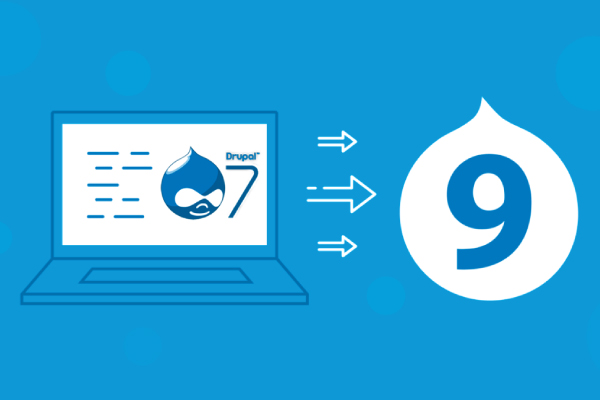Launched on 3 Jun 2020, Drupal 9 brings a powerful platform for enterprises using Drupal to build continuously innovating digital experiences. And now is the time for businesses to start charting how they will make the shift from their existing Drupal version to D9.
Now if you are currently on Drupal 8, the migration path is pretty straightforward. Drupal 9 is backward compatible, and migrating from D8 to D9 is an iterative approach that involves keeping your modules updated and removing deprecated modules. However, if you are one of the 700,000+ sites still on Drupal 7, the migration to D9 will involve a bit more effort to plan and execute.
But despite the not-so-straightforward migration path, the move from D7 to D9 is something that Drupal 7 sites have to undertake sooner or later.
And that is because D7 is reaching end-of-life in November 2022. What this essentially means is that:
- No new features for D7 sites. As developers move to working with newer D8 and D9 modules, even support for existing D7 modules may falter
- Drupal Association will stop supporting Drupal 7 on Drupal.org
- Automated testing for Drupal 7 will stop being supported via Drupal.org
- Drupal 7 will no longer receive official security support - no patches, bug fixes, or security advisories - leaving your site vulnerable
- D7 sites may get flagged as insecure when attempting 3rd-party integrations with other tools
- Hosting service providers like Acquia and Pantheon will also eventually stop supporting D7 sites
As you can see, end-of-life would cease all community support for D7 sites, and businesses have to assume responsibility for hosting, maintenance and other configurations. It also creates a roadblock for any further development and enhancement in terms of the user experience on a D7 site.
What are the Options Available for D7 Sites?
Despite all of this, if businesses still want to continue with a D7 site, they have a few options:
Continue with D7 Unsupported
Drupal 7 sites will continue to work even after the end-of-life date. So businesses can technically continue to exist on D7 without any significant breaks in their current website experience. However, D7 is not equipped to handle or deliver the kind of digital experience and usage patterns that consumers expect from websites today. More importantly, the lack of regular security updates could lead to major compliance challenges for websites, particularly those that work with sensitive user data. All said and done, businesses can continue with D7 if they want, but it is highly discouraged.
Engage Extended Support(ES) for D7
Businesses can opt for the Drupal 7 ES program and partner with a Drupal Association vetted vendor to handle their D7 site. This partnership will involve the vendor disclosing all D7 security vulnerabilities and timely fixing them. The partner would also perform site maintenance, custom development, and other associated website support. However, the ES program from Drupal 7 is only available till November 2025, post which businesses have to replatform - upgrade to D9 or move to a different CMS.
Opting for extended support essentially means taking on an overhead maintenance cost to continue on an open-source platform that's no longer community-supported. However, it might be the best option if do not have the budget to make the shift to D9 right away.
Shift to a Different CMS
Another option for D7 sites is to move to a new CMS altogether. This could be:
Backdrop CMS: A fork of Drupal 7, Backdrop has a built-in upgrade path for D7 websites. The CMS itself will have an easy learning curve for teams familiar with D7, even though there are certain enhancements. Backdrop is designed to work well for the needs of small to mid-sized businesses, unlike Drupal's focus on the enterprise. So the CMS itself is best suited for sites that deliver content primarily through traditional HTML pages. If your current D7 site is planning to remain a traditional website with no further omnichannel ambitions, then shifting to Backdrop can be a good bet. However, if you do plan to shift to D9 at some point in the future, then migrating to Backdrop is not an investment that you would want to undertake, as there is no migration path from Backdrop to D9.
Other CMS: D7 sites can consider shifting to other popular CMSes outside the Drupal universe. WordPress offers migration plugins to simplify the move. However, the possible challenge here is the steep learning curve for long time Drupal teams to pick up the nuances of a new CMS. Also, given the complexity of your existing site, there will be a moderate to heavy investment of time and money to migrate from D7 to a different CMS.
You can also consider a custom CMS. But once again, complexity and the high investments required to build an entire proprietary CMS is something that you might want to reconsider.
Moving from Drupal 7 to Drupal 9
As we can see above, despite some available options, planning and making the move from D7 to D9 is the best bet for a lot of businesses.
Barring an acute budget constraint, or the fact that the D7 site is no longer your primary digital experience channel, there should ideally be no other reason to not migrate to D9.
Once you do decide to migrate to Drupal 9, you can approach it in two ways:
- Migrate from Drupal 7 straight to Drupal 9
- Migrate from Drupal 7 to 8, and then to Drupal 9
While both options are valid, you might want to consider the following before committing to a particular approach:
First, both migration approaches cost roughly the same in terms of time, money and effort investment. The migration from D7 to D8 or to D9 is similar in terms of complexity, and the migration from D8 to D9 is more like a minor upgrade. So in both cases, you deal with planning and executing only one major migration.
Second, because Drupal 9 is just released, it might take some time for the Drupal community to have the whole range of contrib modules compatible with D9. This is something you might want to consider especially if your current D7 site is highly complex with a lot of different contrib modules in place. While a lot of these might have been included in D9 core, there might still be some that will need D9 compatible modules on the marketplace. That said, once you move from D7 to D9 and find that certain modules are still unavailable, you could have to make do without them for a while, and that might be difficult if those modules support business-critical functions. However, migrating from D7 to D8 does not pose this challenge because you can easily roll back to D7 in case of any errors. -
So evaluating your current D7 site and your immediate future requirements against these two parameters can help make the right choice between the two migration approaches.
If you are on Drupal 7, we hope you now have enough information to evaluate if Drupal 9 is your logical next step. Once you make the decision, you next read could be :
- How to plan the migration fro Drupal 7 to Drupal 9
- The Site Owner's Guide to a Smooth Drupal 9 Upgrade Experience
In case you want an expert Drupal team to evaluate your D7 site and help chalk out the migration to D9, we would happy to assist.
Our Services
Customer Experience Management
- Content Management
- Marketing Automation
- Mobile Application Development
- Drupal Support and Maintanence
Enterprise Modernization, Platforms & Cloud
- Modernization Strategy
- API Management & Developer Portals
- Hybrid Cloud & Cloud Native Platforms
- Site Reliability Engineering






